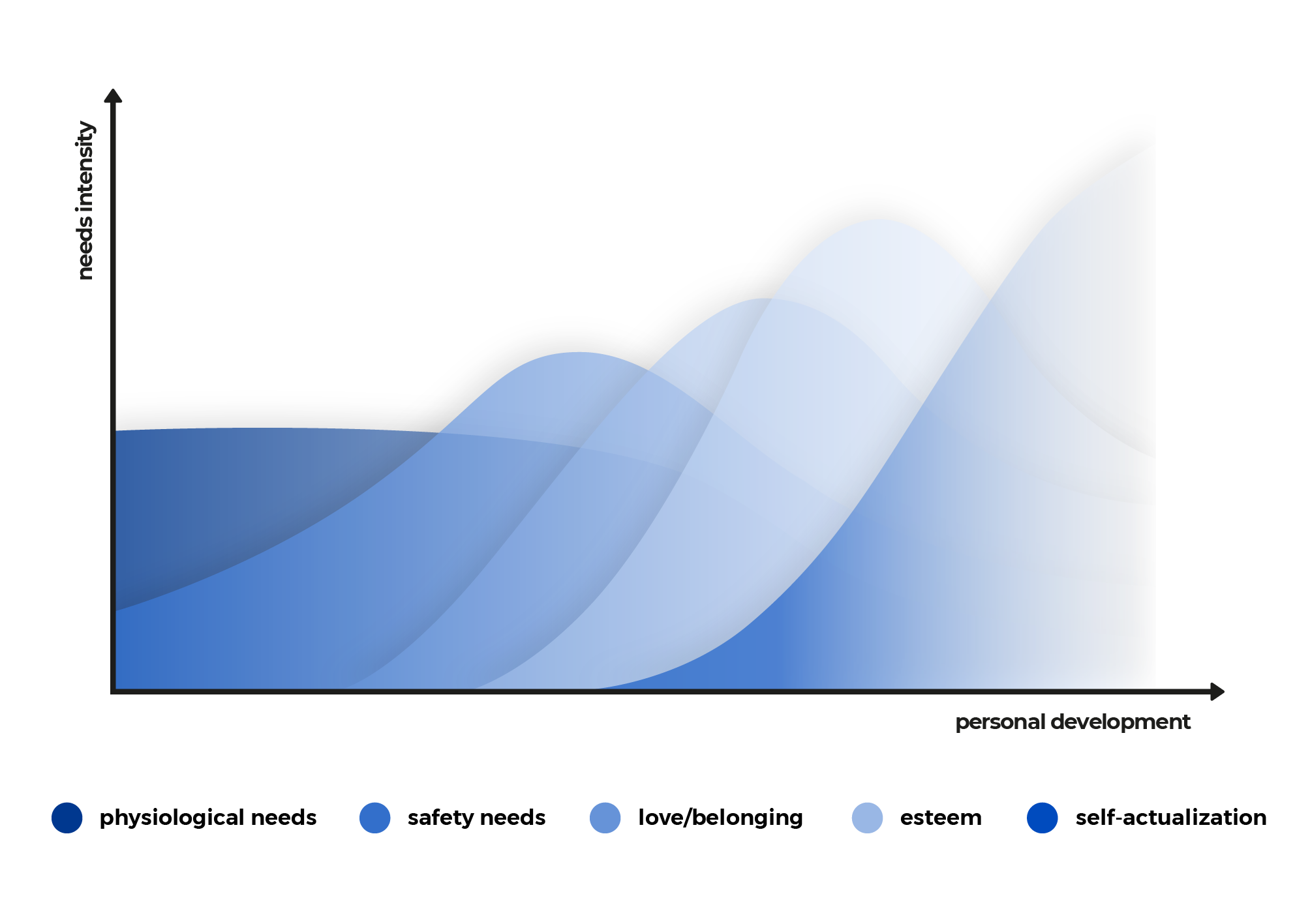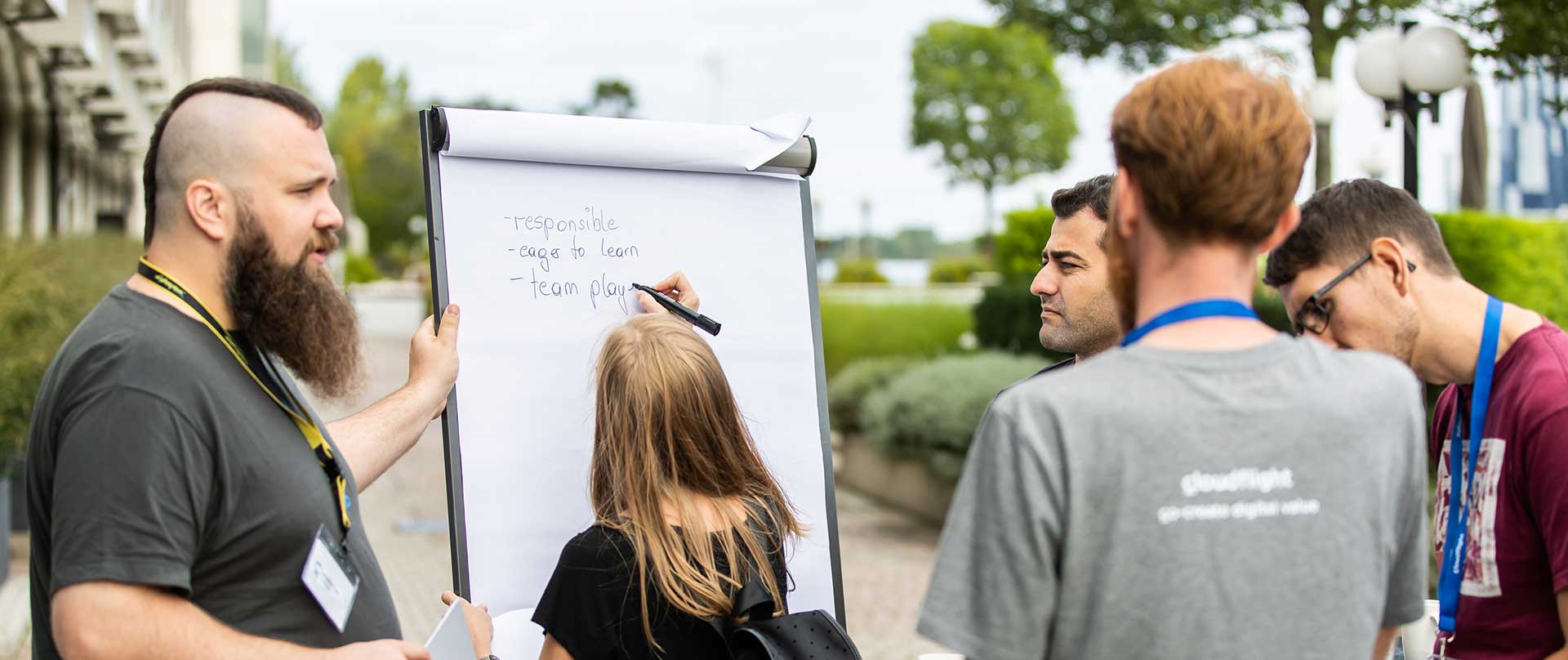When you bring agile to the next level as an Agile Coach, the first things that come to mind are frameworks, concepts and team changes. But in practice, often small improvements start a cascade of changes which brings the whole project and your organisation to the next level. One of these everyday problems is how to motivate your team members as a team leader. In this article I summarized my most commonly used approaches and their related scientific models – get inspired by them!
A Theory of Human Motivation
While studying motivational psychology, one of the first models you will be confronted with is Maslow’s hierarchy of needs. It is a simple concept of motivation. Too simplistic for a professional psychologist, but perfect for helping a new leader understand how motivation works. I can highly recommend taking the 45 minutes to read Maslow’s most influential paper A Theory of Human Motivation – the Maslow pyramid commonly learnt in school, is oversimplified and lacks the key insights we can gain from his work – actually he never talked about a pyramid and its form is misleading. The paper covers basic ideas of his main work Motivation and Personality
But that only applies if it is a real psychological need. How do you know if it is a real need or just a coping strategy or a destructive pattern? There are tons of frameworks on this topic, be it scientific concepts like Reiss’ 16 Basic Needs or business frameworks like Jürgen Appelo’s CHAMPFROGS. What has worked best for me so far: Life experience (and all these models can boost your experience a little bit) and empiricism.
Autonomy – Competence – Relatedness
My personal favorite list of needs comes from the self-determination theory described by Ryan and Deci. Basically, every person who wants to grow needs:
- Autonomy: You want to be able to choose what you are doing.
That’s why the participation and early involvement of stakeholders in projects is so important. - Competence: You want to get better, and this includes the awareness that you are getting better.
In Scrum this is covered externally by reviews and internally by retrospectives. - Relatedness: Connecting and interacting with others on a deep emotional and spiritual level.
Great team spirit is awesome
How do you live them in practice? Cloudflight’s culture and processes cover most of them and we always love to share them in our projects with our customers. Still, we have realized new leaders often struggle with:
- Lead by example: Just do your thing and be transparent in your work. Be the one who lives your values and act in the front line. Let the team members decide what they want to learn from you.
- Care: Know your team members, their goals and their needs. This does not mean that you have to talk about their last breakup. As a leader, connect emotionally with your team depending on your and your team member’s personality. From experience you will mostly talk about technologies and technical things.
How to integrate new members in the company culture?
We are a fast-growing company, and cultural integration does not always happen automatically over time. A concept that helps me a lot can be well experienced in the 30-minute game about the WISDOM and/or MADNESS of CROWDS by Nicky Case which is based on the book Connected by Nicholas Christakis. It describes very well how you can influence others simply by being more present than others. Of course you have to consider time and quality. This means in practice: be present, work closely together with your team and they will become more like you. This is one of the reasons for team planning meetings.
Intrinsic vs. Extrinsic Motivation
But people still ask me: “But if someone doesn’t do what you want – how do you get them to do it?”
My standard answer is: You can’t motivate people. You can only de-motivate them.
But that is partly true. You cannot motivate people intrinsically – that is true. Ryan and Connell described a continuum in extrinsic motivation which helps us to understand how we can support team members in motivation:
- External regulation: Carrot and stick motivation, this is what is usually associated with extrinsic motivation
- Introjected regulation: They do it because others want them to (obligation). “As a developer it is your job to develop, because you get paid to do it”.
- Identified regulation: You take personal responsibility and decide to achieve a goal.
- Integrated regulation: It is fully aligned with your goals. “I want to live in a good world. I want to prevent climate change. And this company will support it to achieve this”.
Just because people want something doesn’t mean that they are intrinsically motivated. Most likely, they have an integrated or identified extrinsic motivation. That is an important difference. As I said before, you can’t intrinsically motivate people (or at least not within our working environment in a reasonable amount of time for your goals) – people enjoy what they enjoy, and that’s fine. But you can help them to focus their work on what they want, and there are several layers at which you can start with. For example, define goals, find goals, discover the underlying needs and connect them to your goals and tons of interventions you can get inspired by the above mentioned responsibility process by Christopher Avery or the solution-focused brief therapy of Steve de Shazer and Insoo Berg and all of their intellectual friends.
Flow – Align the skill level to the work
Such a simple but powerful framework was described by Csíkszentmihályi. And it is one of my most used tools, which I use in coachings with frustrated team members, explaining to them that “they are not bad” and frustration can be solved easily, they just have to adjust their work to their skill level. If they are working on 3 parts of the software at the same time, but are new to the project, this can easily overwhelm them – solution: reduce complexity and focus. And soon they will flourish again.
Unless… they have a leader who is not aware of the Pygmalion effect.
Bonus read: The horse who can read
Once upon a time there was a teacher and he believed that his horse Hans could learn intellectual tasks. He really believed that his horse could do that, so… he achieved it. The teacher asked Hans: “If the eighth day of the month falls on a Tuesday, what is the date of the following Friday?” and Hans would answer by tapping his hoof eleven times. And the teacher would show others Hans’ abilities. And others couldn’t believe it, but the horse could add, subtract, read, spell words and some other nice tricks. After years, a psychologist wanted to put an end to this and formed a commission of 13 experts to investigate the truth. Veterinarian, a circus director, a cavalry officer, several school teachers and the director of the Berlin Zoological Garden, and none of them could find out why Hans could do these tricks, and they were already quite unsure whether Hans was really able to understand the questions and answer them correctly. After a lot of tests finally it was officially announced: “there were no tricks involved in Hans’ performance”.
Today we know that 100 years ago they did not discover the magical intellectual abilities of horses, but that they discovered that horses are really good at observing the reactions of the trainer. And the birth of the Pygmalion Effect – anyone can achieve unexpected things if you believe in them. And if you keep up the hard work – what some people are not used to these days.
50 years later, Rosenthal was able to show that when teachers believe that certain students are gifted, after some time they have a significant increase in IQ tests. Similar studies could show the same for work environments, and in the agile community, books like Turn the Ship Around by L. David Marquet or Leaders eat last by Simon Sinek have taken up this idea.
There is a scientific controversy on the Pygmalion effect, but what I can say from a recent experience: I started paragliding and I make many more mistakes than other students. The instructor started getting angry with me and my mistakes faster and faster. His appreciation decreased and he was less likely to talk about possible improvements and exciting goals. This could have easily created the belief in me that I was a bad student and thus begin a self-fulfilling prophecy. I have been actively engaged in belief change interventions and have focused on empirical observations and improvements to stay in a flourishing state – most people don’t do that.
Always remember that each person’s learning curve is different. And more often than not, those who are slow in the beginning end up being faster than others, if they are not getting demotivated by their environment. Do not raise your expectations of others. Deal with everyone individually, support them decently in their next step and be curious about what is possible.
